Cape to Cairo Journey:
Pages to Explore:
Blog Catagories:
Photo of the day








Home | About Us | Safaris & Photographic Trips | Blog | Contact Us | Sitemap | Disclaimer
The Essence of the Journey!
We would like to do this trip to experience new cultures.
We would like to understand what makes African people pure.
What are their spiritual beliefs, understandings?
How does the spiritual world we know exist to them?
What can we learn from them?

Sep 30 12
Northern Kenya into Ethiopia
Travelling on the road from Marsabit was dusty, hot and tiring.┬Ā Nearly 200kms of jarring. Concentration was at a premium, battling to average 40km/h on this soon to be tarred road.┬Ā After a while I got the feeling I was the only one who did not know about the poor road condition ŌĆō not much traffic.┬Ā We were hoping to see herds of Gerenuk out here, alas mostly camels.
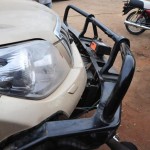 Driving into Moyale, I only noticed the problem as I got out of the car.┬Ā The bulbar was almost ajar. ┬Ā┬ĀMoyale has the same name on both sides of the border.┬Ā The Kenya side looked rather shabby, however I had Kenya shillings, no Ethiopian birr and I had an idea as to how Kenya folk operated.┬Ā They also spoke English.┬Ā The guidebook said though that the Ethiopian side of the border was more of a town, tar road and all.┬Ā
Driving into Moyale, I only noticed the problem as I got out of the car.┬Ā The bulbar was almost ajar. ┬Ā┬ĀMoyale has the same name on both sides of the border.┬Ā The Kenya side looked rather shabby, however I had Kenya shillings, no Ethiopian birr and I had an idea as to how Kenya folk operated.┬Ā They also spoke English.┬Ā The guidebook said though that the Ethiopian side of the border was more of a town, tar road and all.┬Ā
And so approaching 17h00, I decided we should cross over and take a chance with repairs on the unchartered territory side.
There is a constant stream of folk between the 2 Moyales.┬Ā There is no stopping, locals almost accelerate through the border on motorbikes and tuk-tuks.┬Ā Not the ŌĆśmzungusŌĆÖ though.┬Ā We waited for close on an hour for the Kenyan border official to show.┬Ā They did not seem to want, nor get much ŌĆśofficialŌĆÖ traffic between borders.┬Ā This is probably partly because it is so difficult to get an overland Ethiopian visa.┬Ā Other friends like Carol and co had to omit Ethiopia because they did not have a visa.
There is no shortage of folk wanting to help on the Ethiopian side.┬Ā Money changers, hotel finders, car washers, it is over whelming.┬Ā The Ethiopian border officials ask for an inventory of electronic goods and on the most part, were fairly easy going.┬Ā The hotel in Moyale was cheap, although you get what you pay for.┬Ā They did have a proper clay oven and so the food was good, serving delicious thick based bread which was hot and served with honey as well as other local dishes like injera.┬Ā Brook was a helper I sided with, quite frankly I had little choice.┬Ā I needed someone that could speak English and someone that could change USD to birr.┬Ā Brook was really a good bloke, and left me embarrassed at my lack in faith in humans.
The mechanics were a dime a dozen, and quickly came up with the faranji price of 2000 birr for the repair of the bulbar.┬Ā We agreed on half of the opening offer 1000 birr (R500).┬Ā There was a busyness around the car, welders, bolt undoers, managers and more managers.┬Ā As far as problems go, this was a ŌĆśgood problemŌĆÖ to have so far out from a major centre, not too complicated.┬Ā It was dark soon, and hurriedly everyone ŌĆśfinishedŌĆÖ – it was go home time.┬Ā With the work 80% complete, I could finish the rest in the morning light.┬Ā We had to jump start the car, affixing the electrical wires with the lights on had taken some energy out the battery.┬Ā I should have known, the battery, she was starting to be tiredŌĆ”
Northwards to Yabello
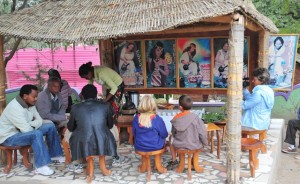
Coffee as the primary export of Ethiopia, coffee ceremonies are an important part of Ethiopian culture.
The roads in Ethiopia are relatively good, that is until the livestock and people appear, on the road, always.┬Ā They also drive on the wrong side.┬Ā
Yabello yielded StresemanŌĆÖs Bush Crow and White-tailed Swallow.┬Ā We could not spend too much time, we needed to get to Lake Awasa, and because we were going to come back the same way, we could have second dibs on any special birds we did not get first time around.┬Ā The Rift Valley Lakes are close together in a fairly straight line.
Lake Awasa
The hotel we were looking for had ceased to exist.┬Ā There were no more lavish gardens full of birds, but in its place a new road.┬Ā Its advertising board was still up though.┬Ā After visiting 3 other places that were all full thanks to it being Ethiopian New Year weekend, we settled on Halle resort, owned by the famous Halle Gabre Selasse multiple world record breaker.┬Ā Clean linen and hot showers, items normally taken for granted were appreciated and welcomed.
Lake Awasa is big and pretty, but probably billed more of a recreational lake than a birding hot-spot.┬Ā We did manage to see Beautiful and Tacazze Sunbirds, Fish Eagles
and Black-winged Lovebird.┬Ā The main idea of Haile though was that Danica & Nicolai could have some down time.┬Ā Table tennis, swimming, television, mini-golf, horse riding, basketball and other kids.┬Ā I could catch up on some work with internet, and we could recover after our rattle and roll drive.┬Ā The Italian influence allowed us to enjoy some good cuisine sans ŌĆśproscuttoŌĆÖ and sans ŌĆśpolloŌĆÖ.┬Ā
Bale Mountains
 Danica & I especially were excited to visit Bale and the home of the rarest canid in the world and the rarest carnivore in Africa ŌĆō Ethiopian Wolf.┬Ā We had also decided that weŌĆÖd give Bale the opportunity of providing the lionŌĆÖs share of the Ethiopian endemic birds, and then weŌĆÖd fill in the gaps thereafter.
Danica & I especially were excited to visit Bale and the home of the rarest canid in the world and the rarest carnivore in Africa ŌĆō Ethiopian Wolf.┬Ā We had also decided that weŌĆÖd give Bale the opportunity of providing the lionŌĆÖs share of the Ethiopian endemic birds, and then weŌĆÖd fill in the gaps thereafter.
Arriving late afternoon at the Bale National Park headquarters, jaws dropped when we saw our accommodation.┬Ā Lousy.┬Ā There was no other option so we had to make the best of it.┬Ā Drizzly weather further dampened our mood.┬Ā The plumbing could not handle toilet paper, so after your number two, you would have to wipe and put the waste in a bin.┬Ā Needless to say, we did not go for two days.
We managed a walk to the offices alongside the park HQ, in search of a booklet that was recommended on the Bale Mountains National Park.┬Ā We were pleasantly surprised to meet Anne -Marie and her friend Zoe.┬Ā They offered us a cup of tea. We shouldnŌĆÖt have but did.┬Ā It was super.┬Ā Anne-Marie is a South African that has been heading up the Simien Wolf project for 3,5 years.┬Ā She has a British husband who was away, doing some fund raising in the USA.┬Ā They rely on external funding.┬Ā But it was great to have some proper coffee, spekulaas, and notice that they had such a snug and comfortable environment in such harsh conditions.┬Ā Even their tea-bags they kept.┬Ā Used ones soaked in paraffin make great fire-lighters.
Anne-Marie was awesome with the children, full of beans.┬Ā We spoke conservation, the threats to the wolves and rhinos.┬Ā We wanted to stay, the whole evening but we could not overstay our welcome.┬Ā So we forced ourselves out.┬Ā Anne-Marie was full of good advice, such as who to speak to at EWCA (Ethiopian Wildlife Conservation Authorities) and where to get a hot shower.
We were in the Bale mountains in the rainy season.┬Ā We did not know, but we would have come anyway.┬Ā We awoke the next day, having scheduled a day trip, through the mountains on horse-back to the waterfall.┬Ā Celeste was not keen ŌĆō she likes horses, but not riding them.┬Ā The kids were thrilled and even though it was raining steadily, they would not hear of cancelling.┬Ā We re-scheduled the ride from 08h30 to 09h30 in hope the rain would stop, and quite frankly the horses were nowhere to be seen.
I admired CelesteŌĆÖs courage, although she did try what she could to postpone/cancel/get out of the trip.┬Ā
09h30 the weather had cleared.┬Ā Danica & Nicolai were smiling.┬Ā ŌĆ£I donŌĆÖt want the man to lead my horse,ŌĆØ Danica said, and so it was.┬Ā Nicolai nagged and after a while he was leading himself too.
┬Ā
Black-headed Ethiopian Siskin, Tekla Lark, Bale Parisoma, Wattled Ibis, were all specials
we noted and had good sightings of on the ride.┬Ā There were lots of people and livestock, this seemed to be the trend in Ethiopia.┬Ā We travelled along the Web valley towards the waterfall.┬Ā We trotted and walked, if the horses got into a canter, there was a shrill cry from Celeste, and we all walked again.┬Ā The horses were impressive, managing on tricky, rocky slopes.┬Ā The waterfall was impressive too.┬Ā Lunch was a mix-up, and we landed up sharing what we had with all.
Then the rain came.┬Ā We were brave at first, but after some time, sought shelter in a nearby mud-hut.┬Ā The humble Ethiopian family was most welcoming and full of smiles, getting a fire going whilst we tried to keep our spirits up with humour as we staved off hyporthermia, Nicolai being the main concern.┬Ā How sobering, being all huddled around more smoke than flame, wet right through helpless to the elements.┬Ā Half an hour felt like three, but there was a break in the weather, and we took it, making it back in the drizzle.
Bale Mountains are one of the standout regions of Ethiopia.┬Ā The high Sanetti Plateau gets to minus 5 at its coldest, with seasonal snow.┬Ā We were happy that it stayed around 10 degrees while we visited.┬Ā There were rodents everywhere on the Plateau.┬Ā This is a good thing.┬Ā The preferred food of the Simien Wolf, we were awed watching these rare canids hunting.┬Ā Elegance personified, they trot confidently, then stop, listen and suddenly pounce.┬Ā They really seem like happy creatures, warm and protected from the elements with their roasty fur coats and smug smile.┬Ā
Bale Mountains National Park ŌĆō Saneti Plateau onto Harena Forest.┬Ā Shoobee doobee do, this landscape is fantastic.┬Ā Sanetti Plateau reaches 4377m and is absolutely unique in nature.┬Ā Despite being described as Afromontane, it has a rainfall that exceeds 1000mm per annum.┬Ā There is often mist over the escarpment, and few plants can survive up here with the ancient moss and lichen.┬Ā Giant Labelia dot the landscape with their special adaptations which include their leathery leaves and tucked away flowers which avoid freezing.
The following day we went over the plateau and down into Harena Forest.┬Ā At this point, air is forced up the escarpment, the result of which is continual topographical rainfall.┬Ā The escarpment acts as a catalyst for the typical mountain weather that occurs in these parts.┬Ā 15 minutes of rain, followed by 15 minutes of sunshine and then 15 minutes of wind, repeat.┬Ā When we arrived at the Harena Forest, we explored and soon noticed East African Swee, Somali Bee-eater, Brown-rumped Seedeater.┬Ā They were extremely active, seemingly taking advantage of the break in the weather.┬Ā The clearing at the Katcha campsite looks onto the escarpment and possibly the most pristine area of the forest.┬Ā There is a gentle stream that flows through the clearing and every now and again cows and horses appear, with the odd herding adolescent.┬Ā
I was lured into a level of comfort and enjoyment looking on these part endemic, part boisterous feathered jewels White-cheeked Turaco, boiling water at the back of Staffie for some tea and Coffee.┬Ā It was approaching 14h00 and we had missed breakfast.┬Ā Blissfully unaware, our faulty battery was not coping with lights that were on in the vehicle with doors open, etc.┬Ā Needless to say the setting seemed to ensure the coffee tasted even better than normal.┬Ā Once packed up, one spark, two but no uptake.┬Ā Like a rattle at a soccer match, and a shriek from Celeste ŌĆō confirmation we were going nowhere.
I got out the jumpers and connected them to the auxiliary battery, maybe.┬Ā Splutter, splutter, better but no take.┬Ā I got out the solar panel and thought to get the sun to charge up the battery.┬Ā The clock had been ticking and the rainŌĆÖs turn had come.┬Ā It started off as a drizzle, and the solar charger registered a trickle of a charge getting to the battery.┬Ā It started raining harder, getting darker too.┬Ā We were about 10km from the nearest village, it was not looking good.
ŌĆ£So whatŌĆÖs the plan?ŌĆØ Celeste asked as I climbed into the car avoiding the heavier rainfall, 3 pairs of eyes fixated on their husband/father.
I had tried to engage with a nearby herd boy, requesting him to summon someone with a motor vehicle.┬Ā I was not hopeful, but relayed the message to the family.
With the hood down on the charger, rain pouring down steadily, I suggested to my frustrated wife that there were two options.┬Ā The first was to wait patiently for the sun, which must be up there somewhere past the inky blue clouds, to charge up the battery.┬Ā Although this was theoretically possible, was it a realistic option?┬Ā We had come down the escarpment through continual cloud cover and the clock had seemed to jam, there was no sign of the clouds clearing.┬Ā If it got to 17h00, and the battery was not charged sufficiently, we would be in an even deeper fix.
The other option was to leave the family in this foreign place, miles away from anyone they knew, and go for help.┬Ā┬Ā This was probably the better option I thought.┬Ā I packed my pockets with mobile phone, GPS, some cash and gave Cel the estimate that IŌĆÖd be back in about two hours.┬Ā She said that the village was further than that and what should she do if ŌĆ”?┬Ā I said not to worry and IŌĆÖd return before dark, worst case scenario, weŌĆÖd sleep in the car.
With the rain bringing the temperature down to about 8 degrees I set off.┬Ā It was better than sitting around and waiting.
The dead-end road from Katcha campsite twists and turns for about 3kms until it joins a bigger twistier & turnier road.┬Ā From the junction, the road climbs steeply to the one horse town of Rira another 10kms away.┬Ā I was some way up the road when I heard the sound of an engine, yes, yes a bus.┬Ā I took my hood off to show that I was a respectable faranjiand started flagging down the bus desperately ŌĆō it simply had to stop.┬Ā It had no choice, the road was not very wide and I was in the middle of it.
Celeste had aided me with a few translations jotted down hurriedly in a notebook, and so immediately I said help, car in Ethiopian and then in English ŌĆō battery and then in a charade type way, acted out death.┬Ā The heads hanging out the bus window laughed, probably more at seeing a sodden, helpless faranji than anything else.┬Ā Not far I said, repeating the broken sentence to other folk that had emerged from the bus.
I was offered a seat on the velvet upholstered roof of this un-roadworthy passenger vehicle, designed for about 30, but carrying about 55.┬Ā ŌĆśSalamŌĆÖ I greeted the passengers as I entered the vehicle.┬Ā There were some laughs and then a lady near the front argued with the driver, probably because she did not feel like a detour.┬Ā My seat was an empty, used 50l oil container, and I sat showing I understood their gesticulations and politeness.
As we approached the junction and the turn-off to where the vehicle and family stood waiting, I mentioned to the men that it would not be possible to push the vehicle as it was an automatic.┬Ā The penny tinkled and clattered as it dropped as the driver stopped at the Kitcha junction ŌĆśnot possibleŌĆÖ he said.┬Ā ŌĆśBattery no energyŌĆÖ with me standing on the side of the road, he turned the vehicle around on the road, leaving its nose facing down the hill to later jump start the engine. ┬ĀHe then switched the small buses engine off.┬Ā He continued to prove to me by trying to start the bus, which clearly was not going to happen.┬Ā His battery clearly had no energy.
At this point I did not know whether his battery was gone or his alternator not working, but this was the tipping point of inconveniencing his passengers.┬Ā With little English between us I said ŌĆśnot to worry ŌĆō itŌĆÖs okŌĆÖ and said good bye.┬Ā One of the bus assistants gave me a piece of chewing gum, as he climbed into the bus, banana flavoured, I guess in an emotion between pity and apathy.
So I was on the same road again walking in the rain towards Rira.┬Ā Just short of an hour wasted, I smiled at myself ŌĆō despite the good intention of the folk in the bus, they had wasted my time.┬Ā I was not too phased, but it was now 15h00, and there was no more room for error.┬Ā I had a weird thought that if we landed up spending the night in the motor vehicle, and there were any un-savoury characters on the bus, we could be sitting ducks.┬Ā No room for negative stuff, focus on the task at hand.
I walked much further on the road this time.┬Ā There was a break in the weather and there were birds frittling around on the canopy.┬Ā An old lady and her son herded their two laden donkeys. It seemed they had just come from town, having done some trade.┬Ā I greeted them with a smile as they passed, I got a ŌĆśehŌĆÖ, looking down as we crossed over on the road.┬Ā At the top of one of the switchbacks, there was an approaching bus, coming from the opposite direction.┬Ā I flagged the vehicle down, the driver seemed like an Indian man, with a lighter coloured skin.┬Ā He spoke better English and quickly understood my predicament, ŌĆś1000 birr he said harshlyŌĆÖ.┬Ā This was extortion in action.┬Ā The equivalent of a poorly paid labourers monthly wage for probably 10 minutes assistance.┬Ā I shook my head and said 500, knowing I had little choice, we agreed on the lower amount.
Being the 5th person in the cab, the trip back to the stationary vehicle was tediously slow.┬Ā I was anxious that the truck would say it too far and renage on our arrangement.┬Ā I neednŌĆÖt have; he was getting paid well.
I was surprised to see another vehicle next to ours there was a small crowd of folk, and Celeste was out the vehicle hovering around the bonnet.┬Ā I asked how this vehicle arrived at the scene, Celeste did not know.┬Ā He was undoing my battery, replacing it with his.┬Ā Jumpers had not worked.┬Ā This was the right thing to do.┬Ā Unfortunately the terminals were the wrong way round, and with my cables too short, the bloke that had driven me to the scene, set about taking one of his batteries out.┬Ā Staffie jumped to life.┬Ā
An easy problem to solve in a 1st world environment, has cost a fortune in time and money to solve in Ethiopia.┬Ā I asked my bloke if I could split his payment with the other helper.┬Ā I got a cynical grunt, ŌĆ£400 birrŌĆØ.┬Ā I had agreed to the fee, so I paid each 400 birr.┬Ā I asked Celeste where the other driver had come from.┬Ā There are very few cars, correction, no cars where we were stranded, so how did he arrive?┬Ā It turned out that one of the folk from the bus had told him of our predicament, and he had come to our aid.┬Ā His demeanour was different to the bloke IŌĆÖd come across, but how was I to know?┬Ā Problem solved, I had learnt another lesson.





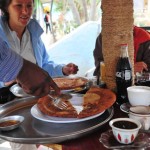


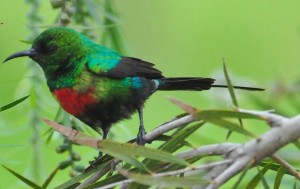

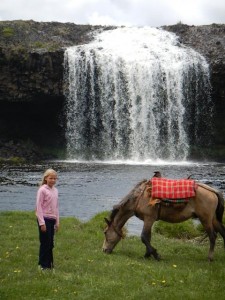


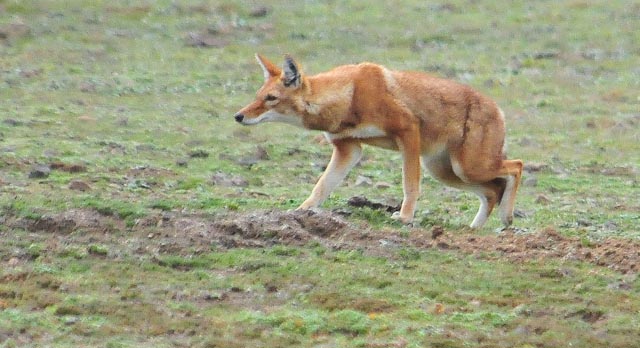

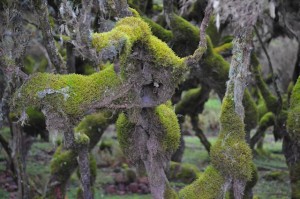
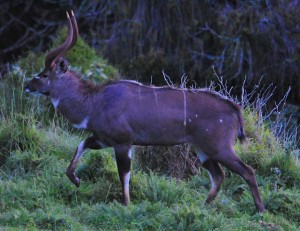

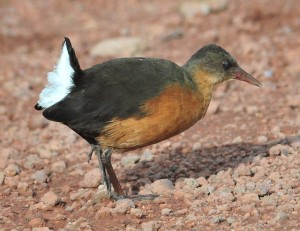
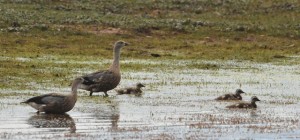
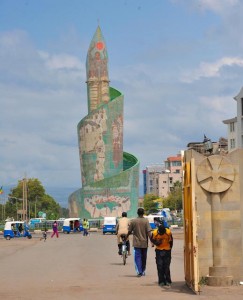


One comment and your storeytelling improves, celeste I miss your blogs Please come back! Miss you guys. And NO Marcello I don’t want to buy the car. Have fun! Cheers for now
Hi Guys. Thanks for the great blog. Hope you can find a new battery soon.
Ok, now we are jealous. You saw the wolf!!!!!!!! We only heard them. Hurumph!!!!!!!!
M: AVB doing better, somethign to do with beating Man U last weekend!